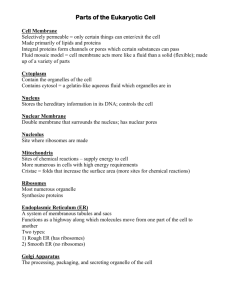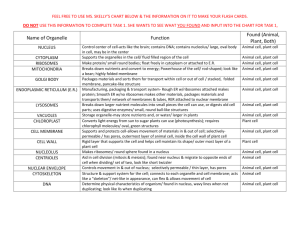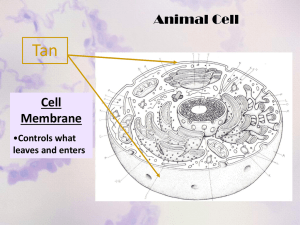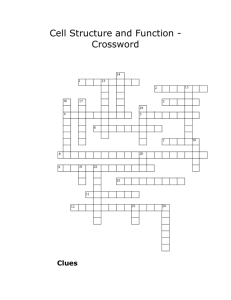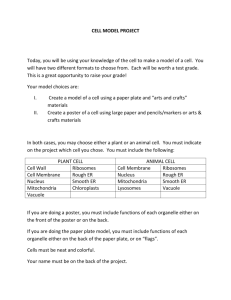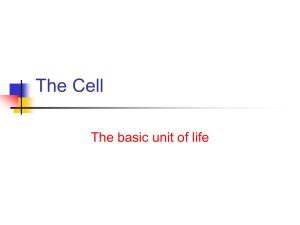Cell Organelles: Structure and Function Presentation
advertisement
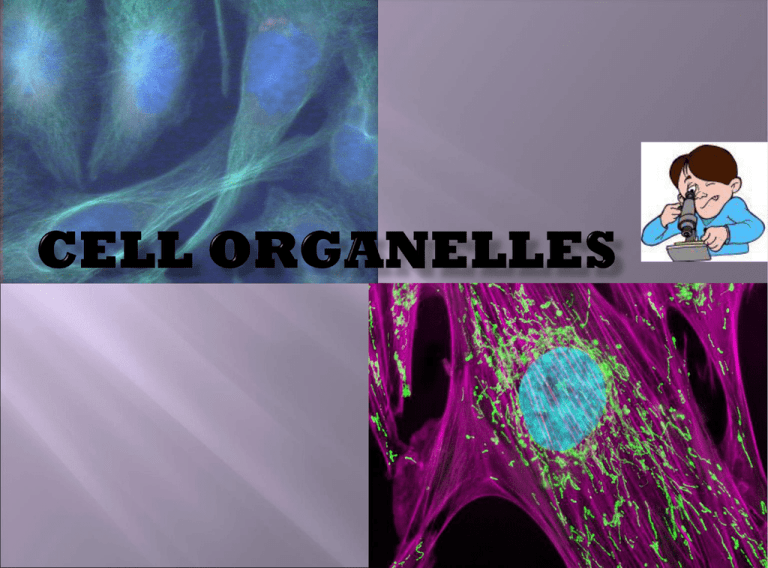
Cells Prokaryotic (no nucleus) Only Organelles Are the Ribosomes All are unicellular Example: Bacteria Eukaryotic (has nucleus) All of the Organelles Unicellular Example: Amoeba Multicellular Example: Human Organelle is called the Found only inside eukaryotic cells ( that’s what we are made of) Each one has a very specific job inside every cell in living organisms Boundary of the cell Allows materials in and out of cells Also called the? Control center or the of the cell Contains DNA which is? Surrounded by a double membrane Usually the easiest organelle to see under a microscope Usually one per cell Located inside the nucleus What is the job of the Nucleolus? Acts as skeleton and muscle Provides shape and structure to the cell Helps move organelles around the cell Made of three types of filaments A.k.a. “ER” Transports materials throughout the cell It is called the of ______ the cell Rough ER: Has Ribosomes on it Smooth ER: No Ribosomes; it makes lipids Site of protein synthesis Can be attached to rough ER or floating free in cytoplasm Called? Produced in a part of the nucleus called the? Looks like a stack of plates Called the_____ of the cell? Stores, modifies and packages proteins Molecules transported to and from the Golgi Body by the? Called the______ of the cell Contain digestive enzymes that break down wastes and old organelles It is called the? Cellular respiration occurs here: Has a double membrane Has its own strands of: Found only in? Contains the green pigment………..? Where food, glucose a simple sugar for the cell is produced Has a double membrane Found only in and cells What does it do? Located outside of the cell membrane Made of cellulose (fiber) Large central vacuole mainly in ……….cells? What is the job of the Vacuole? Helps in cell division or……..? Usually found only in animal cells Made of microtubules Cells 1. Which organelle is the “Powerhouse” and why? A: Mitochondria, makes energy for the cell. 2. Name the 2 types of Endoplasmic reticulum or ER A: Smooth ER and Rough ER 3. What is the main difference between them? A: Rough ER has Ribosomes on it Smooth ER has no ribosomes 4. What is the nickname for Ribosomes? A: The “Little factories” 5. Why? A: Because Ribosomes produce or make proteins 6. Why is the cell membrane called the “Gatekeeper? A: Because it controls what substances can enter and leave the cell. 7. Why do you think that is important? A: Try to keep out harmful substances out, allow Glucose, water and Oxygen inside. Allow waste products to leave the cell, such as Carbon Dioxide 8. Which cell type has a cell wall, plant cell or animal cell? A: Plant cell 9. In which organelle in plant cells is Glucose produced? A: Chloroplasts 10. Why do you think plant cells have much larger vacuole than animal cells? A: Plant cells store Glucose, water and other materials
